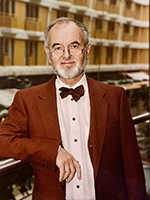Manfred Zimmermann

Manfred Zimmerman, co-founder of EFIC and its second President (1996-99), passed away in May 2024. He was 90 years old. Those lucky enough to have known him personally will remember his fabulous energy, his dry sense of humour, the dread of going for a drive with him and, above all, his enormous contribution to pain research and pain medicine. We at EFIC are all very sad, and I invite you warmly to read the text below, written on the occasion of Manfred’s 90th birthday by Professor Hermann Handwerker, who knew him very well.
Luis Garcia-Larrea
President, European Pain Federation
We are pleased to publish this Laudation for Prof. Manfred Zimmermann on the occasion of his 90th birthday, written by Hermann Handwerker, EFIC Honorary Member and former EJP Editor-in-Chief.
Manfred Zimmermann was a founding member of EFIC and from 1996 to 1999 its second president after Ulf Lindblom. He is a major pioneer in pain research with an extraordinary career as a scientist and science organizer. He started his academic career by studying physics at the Technical University of Karlsruhe, after promotion he worked as a postdoc in a biophysical laboratory at this university. His scientific career took a turn when he moved to the Medical Faculty of Heidelberg University in 1964 to R.F.Schmidt’s working group at the 2nd Physiological Institute. There he completed his habilitation with research on presynaptic inhibition, an important synaptic mechanism for controlling and adapting the signals of peripheral nerve fibers as they enter the central nervous system from the periphery of the body. This mechanism had been discovered a few years earlier by the later Nobel Prize winner J. C. Eccles in Canberra.
In the course of this work a sensational publication in Science by Melzack and Wall (1965) piqued Zimmermann’s interest. This publication described a “gate control” theory of pain. The two authors proposed a presynaptic mechanism by which the fast-conducting (A) nerve fibers inhibit pain-inducing input into the CNS, while the thin (C) nerve fibers enhance it. However, Manfred Zimmermann was able to refute this simple explanation of the “gate” with an elegant physiological experiment in which he demonstrated that C fibers as well as A fibers can induce presynaptic inhibition (Science 1968). However, the broader idea that it is not peripheral “pain receptors” but control mechanisms in the spinal cord and brain that underly pain sensations did not disappear, but was corroborated by later research. The term “gate control theory” is still occasionally used for this.
With this groundbreaking work, Zimmermann has entered pain research, which determined his later scientific career. He set up a research group at the University of Heidelberg with which he carried out important work on the excitation of C-fiber nociceptors and the synaptic processing of nociceptive input in the spinal cord from the 1970s onwards. His intense scientific interest also focused on descending inhibition, with which the brain controls the transmission of nociceptive signals in the spinal cord. Melzack and Wall had already proposed such a control in their above mentioned original publication, but still without experimental evidence. Zimmerman attracted visiting scientists from all over the world to his laboratory. Among them were important scholars such as Y. Zotterman from Stockholm, who had first described C-fiber recordings already before the second World War. A guest and coworker was also A. Iggo from Edinburgh, who had first determined C-fibers by their conduction velocity. Further coworkers were G. Gebhardt from Iowa (USA), J. Solcsanyi from Pecs (Hungary), M. Rowe from Sydney (Australia), to name just a few. He himself was a visiting professor at Monash University in Melbourne and at the Universita di Siena. The latter university awarded him an honorary doctor of medicine. In addition to his own scientific work, Zimmermann was fruitful as an editor of scientific journals and organizer of scientific conferences. Particularly worth mentioning is his many years of work as E-i-C of “Neurosciene Letters” and as co-chairman of the annual European Pain School in Siena (2003-2016).
Zimmermann took an intensive part in the formation of international organizations for pain research. He was a co-founder of the International Association for the Study of Pain (IASP) (1973), then he was a co-founder of the “Society for the Study of Pain for Germany, Austria and Switzerland” (1975) of which he became president (1984). He transferred this German-language chapter of the IASP to three national pain societies in 1990 and was then president of the German Pain Society (DSG) until 1996. I already mentioned at the beginning that he was a co-founder of the EFIC (1993) and became its second president.
He recognized early on that progress in pain therapy depends on interdisciplinary collaboration between different disciplines and sought the collaboration of psychologists and physicians. He was the initiator of interdisciplinary pain conferences and, as president of the DSG, took part intensively in the formulation of a national algesiology curriculum for doctors. For his contributions to pain research, he has received several awards and been made an honorary member of the IASP and the DSG, as well as several other national pain societies. In 2004, the German government awarded him the Federal Cross of Merit with ribbon (Das grosse Bundesverdienstkreuz am Bande).
A bibliography of Manfred Zimmermann can be found in Neuroscience Letters 361 (2004) 272-280.
We wish Manfred Zimmermann all the best on his 90th birthday.
Hermann Otto Handwerker




















